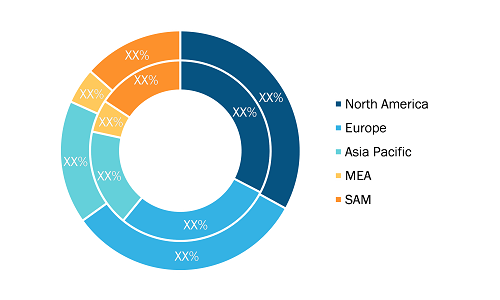The unmanned traffic management market size is expected to reach US$ 3,234.28 million by 2030; registering at a CAGR of 17.8% from 2022 to 2030, according to a new research study conducted by The Insight Partners.
Rising Adoption of Drones in Logistics and Supply Chain Management
There is a rising popularity for unmanned aerial vehicles (UAVs) and unmanned aircraft systems (UASs), commonly referred to as drones, across the globe. Innovative UASs and UAVs have been increasing in the airspace, boosted by advancements in both underlying technology and ancillary functions. The US governments' Federal Aviation Administration (FAA) anticipates the registration of 1.6 million consumer drones by 2023 in the US and forecasts that 835,000 small unmanned aircraft systems will also be registered in that same time frame. Additionally, the growth of autonomous driving and robotics industry have been fueling the research on technologies such as global positioning system (GPS), global navigation satellite system (GNSS), microelectromechanical systems (MEMS), hydrogen fuel cells, satellite communications, and optoelectronics. Since such technologies are also required for UAVs and UASs, the development and adoption of such vehicles are being promoted. It has also led to increased intellectual property (IP) developments for major drone industry companies in various countries. Infrared Thermography (IRT) and Hyperspectral Imaging (HSI) are technologies that have witnessed an increased number of patents globally. IRT and HSI are vital technologies for camera-based navigational systems. Utilizing uncooled microbolometers as focal plane array (FPA) sensors in specialized thermal imaging cameras is one such advancement, which is expected to promote the application of drones for commercial usage.
Unmanned Traffic Management Market – by Geography
Unmanned Traffic Management Market Size and Forecast (2021 - 2031), Global and Regional Share, Trend, and Growth Opportunity Analysis Report Coverage: By Type (Persistent UTM and Non-Persistent UTM), Component (Hardware and Software), Application (Communications, Navigation, Surveillance & Monitoring, and Others), and End Use (Agriculture & Forestry, Logistics & Transportation, Surveillance, and Others), and Geography
Unmanned Traffic Management Market Size and Growth by 2031
Download Free Sample
Source: The Insight Partners Analysis
All the factors mentioned above are strongly driving the adoption of UAV and UAS, leading to congestion of low-altitude airspace. Unmanned traffic management (UTM) enables the management of multiple drone operations without allowing the signal from one drone to interfere with another. UTM has increased importance beyond visual line-of-sight (BVLOS) drone operations, where air traffic services are unavailable. It enables cooperation between the drone operators and the Federal Aviation Administration (FAA), allowing for a better understanding of the airspace and reducing the chances of untoward incidents. Thus, the technological advancements of UAS are promoting the applications of UAVs and drones, thereby boosting their number, in turn, driving the demand for UTM solutions globally.
The unmanned traffic management market is segmented on the basis of type, component, application, and end use. Based on type, the unmanned traffic management market is bifurcated into persistent UTM and non-persistent UTM. By component, the unmanned traffic management market is bifurcated into persistent hardware and software. The hardware segment accounted a larger share in 2021 with growing investment in new product development. Rising integration of advanced sensors and telematics in UASs has boosted the segment growth. By application, the unmanned traffic management market is segmented into communication, navigation, surveillance & monitoring, and others. The communication segment held the largest share in the market in 2021. In terms of end use, the market is segmented into agriculture and forestry, logistics & transportation, surveillance, and others. The logistics and transportation segment dominates the market due to major adoption of UASs in logistic services. The key players profiled in the unmanned traffic management market study are Lockheed Martin Corp, Leonardo SpA, Thales SA, Raytheon Technologies Corp, Altitude Angel Ltd, Frequentis AG, AirMap Inc, Unify NV, OneSky Systems Inc, and Thales SA. The unmanned traffic management market report provides detailed market insights, which helps key players to strategize their growth in the coming years.
Impact of COVID-19 Pandemic on Unmanned Traffic Management Market
Owing to the ongoing COVID-19 outbreak, governments in regions such as Europe, Asia Pacific, and North America imposed stringent limitations on corporate activity and the movement of products and persons in 2021. These restrictions created negative impact on both supply and demand for traffic management solutions, affecting the worldwide unmanned traffic management market’s revenue growth, particularly in 2021. The unmanned traffic management market is likely to stabilize in 2022 and is anticipated to witness growth from 2022 to 2028.
The COVID-19 pandemic was an eye-opener for most business verticals, as it caused widespread supply chain disruptions, leading to a temporary or permanent closure of several businesses. The rising adoption of drones is also fueled by their capability of reducing human contact, thus allowing for the avoidance of similar situations that arose during the pandemic.
Contact Us
Phone: +1-646-491-9876
Email Id: sales@theinsightpartners.com